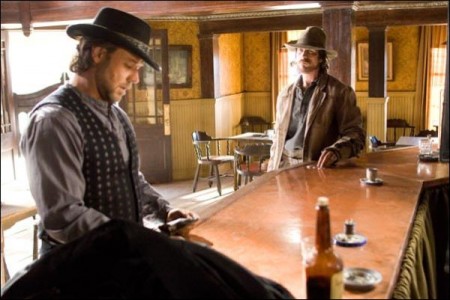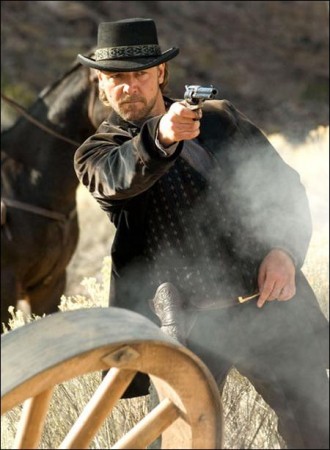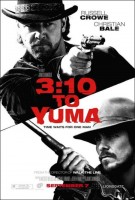Tagline: Time waits for one man.
In Arizona in the late 1800’s, infamous outlaw Ben Wade (Russell Crowe) and his vicious gang of thieves and murderers have plagued the Southern Railroad. When Wade is captured, Civil War veteran Dan Evans (Christian Bale), struggling to survive on his drought-plagued ranch, volunteers to deliver him alive to the “3:10 to Yuma”, a train that will take the killer to trial.
On the trail, Evans and Wade, each from very different worlds, begin to earn each other’s respect. But with Wade’s outfit on their trail – and dangers at every turn – the mission soon becomes a violent, impossible journey toward each man’s destiny.
“3:10 to Yuma” is a remake of the 1957 Western toplining Glenn Ford. The movie stars Russell Crowe, Christian Bale, Ben Foster, Gretchen Mol and Peter Fonda in a modern take on the classic western by Elmore Leonard from producing/writing/directing team Cathy Konrad and James Mangold (“Walk the Line”).
Originally published in 1953 in Dime Western Magazine, Elmore Leonard’s short story “3:10 to Yuma” reached the screen four years later in a film directed by Delmer Daves from a screenplay by Halsted Welles. The plot is simple: a cash-strapped named rancher Dan Evans volunteers to escort infamous outlaw Ben Wade to a prison-bound train.
Director James Mangold was seventeen when he first saw the 1957 western and it made a lasting impression on him. “It startled me because the questions the film asked about morality, courage, honor and family were very sophisticated. The characters of Ben Wade and Dan Evans are much more complicated than simple black and white hats, and the story presented not only the potential for action but also a kind of claustrophobia — unique among westerns — one that forces these opposite characters into a very close and intense proximity.
Mangold drew inspiration from 3:10 to Yuma in writing and directing his second feature, Cop Land (1997), an acclaimed drama starring Sylvester Stallone as an unassuming small-town sheriff who faces down a group of corrupt New York City cops. “Cop Land was modeled on 3:10 to Yuma,” says the director. “In fact, I named the main character, Sheriff Freddy Heflin, after Van Heflin, who played Dan Evans in the original film.”
Mangold began to seriously entertain the notion of remaking 3:10 to Yuma while directing Identity (2002) for Columbia Pictures, which owned the film rights. “It struck me: why not actually try to tackle the original film and the original story ideas from a modern perspective?” he says. “Sometimes the most attractive land is the land that hasn’t been plowed lately and the western seemed to me to have been abandoned in the last decade. Yet it’s such an integral part of American moviemaking.”
Mangold’s longtime producer Cathy Konrad, whose professional collaboration with the filmmaker dates back to Cop Land, was enthusiastic about a potential remake. Konrad, who first saw the 1957 3:10 to Yuma during the production of Cop Land, felt a contemporary audience could appreciate the story of an ordinary man forced to test himself in the harshest of circumstances. “I think that people want to relate to heroes who are real people. There are other ways to look at the world and to look at conflict other than superhero stories,” she comments.
“There’s something very compelling about the struggles that people face in westerns, defining themselves, settling land, building families. There are no easy ways to solve problems. You really have to dig deep inside yourself and think about who you are and what matters to you. The backdrop may be the past, but the themes are very modern.”
As Mangold got deeper into writing Walk the Line, he and Konrad tapped the writing team of Michael Brandt and Derek Haas to begin work on revisions to the 3:10 to Yuma screenplay. Mangold and Konrad were deeply inspired by the original screenplay by Halsted Welles, a respected writer whose credits included the Gary Cooper classic The Hanging Tree (1959) and over 100 hours of live television during the “Golden Age.”
However, Mangold and Konrad wanted the trek from Bisbee to Contention, barely glimpsed in the original film, to be further dramatized in their production. They worked together with Brandt and Haas to carefully devise the route that takes Wade and his guards into Apache territory, as well as into the mountains where crews are blasting through rock to build the transcontinental railroad. They developed new characters, including Byron McElroy (Peter Fonda), a bounty hunter who has tangled with Wade before.
Says Brandt, “We all loved the original, and we wanted to figure out a way to make it for modern audiences. Jim’s focus was, ‘let’s make it gritty. Let’s make it real.'”
“3:10 to Yuma depicts a world where violence is as commonplace as corruption. It’s a place where Ben Wade, a charismatic but remorseless killer, can not only thrive but acquire a legend. He is the kind of outlaw romantically portrayed in the dime novels beloved by Dan’s oldest son, Will. Comments Haas, “Wade is tough and glamorous, the equivalent of a modern rock star.
He’s the guy that everybody wants to be — except when you’re the guy holding the gun on him.” Wade’s dangerous appeal is central to the new film’s exploration of hero — and anti-hero — worship. In fleshing out that theme, the filmmakers chose to expand the role of Will Evans, who was seen in only a handful of scenes in the original film. In the new version, the 14-year-old is enthralled by Wade and sneaks away from home to join the posse escorting the criminal to Contention.
Comments Mangold, “It’s almost a love triangle, with Dan Evans and Ben Wade vying for the affection of this kid, who is charmed by this killer and bowled over by the fact he is well-mannered, educated and highly intelligent, perhaps even brilliant. Wade, in many ways, embodies a male fantasy: the superman character that is both lethal and gentle. Having Will become more present throughout the film really allowed us to explore the reality of fatherhood, the reality of providing, the reality of being law-abiding versus the fantasy of the life that Ben Wade lives.”
If Mangold was intent on modernizing the western in terms of action and atmosphere, he was equally focused on casting the film with actors who possessed the authority of classic western heroes and villains. “It was important to convey that sense of masculinity, power and capability, which is intrinsic to the western,” the director remarks.
With that in mind, Oscar-winner Russell Crowe (Gladiator, A Beautiful Mind) was a natural choice for the cunning, charismatic Ben Wade. “Russell was who we always thought of for Wade, and he brings a clean, crisp, masculine commitment to the role. It’s hard to make that leap into period films and figure out how to be yourself in them and somehow not bring down the scenery and the façade of that world. And Russell truly is himself in L.A. Confidential, in Gladiator, in 3:10 to Yuma, yet at the same time he’s completely true to the period.”
For Crowe, accepting the part was an easy decision. “I’d wanted to work with Jim for a while and there was a basic energy to the Ben Wade character that I liked,” he explains. Wade is a man of implacable resolve and lightning judgment; a man who does him wrong can expect no mercy.
Crowe believes his character’s stern perspective is hard-earned and colors his every action. “There’s a scene where Wade discusses a time when he read the Bible from cover to cover, and the reasons why he read the Bible from cover to cover. That, to me, is the central core of who Ben is. It wasn’t a very pleasant experience for him when he read the Bible cover to cover, and I kind of took the attitude that he doesn’t believe in a benevolent God. He got stuck somewhere in the Old Testament, and hasn’t come out of there yet.”
Christian Bale (Rescue Dawn, Batman Begins) portrays Dan Evans, the beaten-down rancher and Civil War veteran who rediscovers his sense of strength and moral purpose while fulfilling his pledge to take Wade to the train. As Mangold describes the reluctant hero, “Dan Evans is a man who is living life tied back, limping along trying to deal with the obstacles getting thrown at him. That made it interesting to cast someone with the kind of strength that Christian has. Christian has a kind of intensity and integrity that leaps out of his eyes. I think it makes for a really noble character, someone who you identify with.”
Bale eagerly took on the role. “I like to read a lot of scripts, but very rarely does one really stick with you. And this one did. It was a great story and a classic morality tale, as most westerns really are.” He was intrigued by the dynamic between Evans and Wade, who forge a singular friendship during their three-day journey. “There’s a great battle of wills between the two, and a clash of philosophies; but there is an understanding and agreement about what society is. But they have absolute opposite approaches about how to deal with that society.”
Ben Foster (X-Men: The Last Stand, “Six Feet Under”) was cast as Wade’s loyal, exceptionally ruthless right-hand man, Charlie Prince. Konrad praises Foster for finding notes of filial pride in the young gunslinger. “One could have read the script and thought Charlie Prince is the baddest bad guy ever. But what Ben brought to it was an incredible vulnerability. Charlie loves his boss, loves working for Ben Wade. Ben injected this whole other dynamic to relationship that added so much.”
To Foster, Prince’s violence is not only part of his nature, it is inherent in his circumstances and his time. “I’m playing a man who’s trying to rescue someone who means a lot to him,” he explains. “And it is the Old West and, and the morals of survival are a lot harsher. Life is cheap.”
Oscar-nominated Hollywood legend Peter Fonda (Ulee’s Gold) joined the cast as the bounty hunter Byron McElroy. There is a tension between the bounty hunter and Wade that goes deeper than a simple conflict between authority and criminal. “I think they’re different sides of the same coin,” remarks Fonda. “They’re both killers, only McElroy is supposedly working for the law and Wade is working on his own to bag all this loot from the railroad.”
Fonda, who made his own directorial debut with the 1971 western The Hired Hand, applauds Mangold for an approach that suited both the genre and the story itself. “There’s lots of action, which is the way we appreciate things today. But also I think it’s a better way to tell the original 3:10 story, a better way to show character development. This is an epic western with a lot of punch.”
The combination of filmmakers, story and stars lured a superb supporting cast that includes Gretchen Mol (The Notorious Bettie Page) as Alice Evans; Logan Lerman (The Number 23) as Will Evans; Dallas Roberts (Walk the Line) as Grayson Butterfield; Alan Tudyk (Knocked Up) as Doc Potter; Kevin Durand (Wild Hogs) as Tucker; and Vinessa Shaw (The Hills Have Eyes) as Emma, a saloon girl who catches Wade’s fancy.
Production on 3:10 to Yuma got underway in New Mexico on October 23, 2006 and lasted 54 days, wrapping up on January 26, 2007. The film is Mangold’s third with acclaimed director of photography Phedon Papamichael, following Walk the Line and Ýdentity. Director and cinematographer staked out a modern, unfussy style they believed suited the film’s suspense and physicality. “This film is not like a Dances With Wolves. It’s not about the scenery and the landscape and the scope,” says Papamichael. “We wanted to have a rougher, looser feel. People get hit unexpectedly. So we wouldn’t really design the specific stunt shots or set-ups that incorporate a stunt. One of my inspirations was the battle scenes in Saving Private Ryan. We did a lot of hand-held work, a lot of running with people.”
“It was important that the film feel very aggressive, very alive and in the moment, and not like we were doing a kind of tribute or imitation of an old film,” Mangold explains. “I actually tried to forget about a lot of the great westerns, to the degree that I just shot it like I was shooting it in New Jersey or New York City or Los Angeles or anywhere else. Just shoot it like it was happening; there are natural grooves that you’re going to fall into, the way people arrange themselves in a frame in a gunfight. It’s not like you’re going to come up with the whole world anew. But if you’re not quoting other films, I think you’re starting from a better place.”
3:10 TO YUMA delivers a visceral sense of life in the Old West, depicting a world that is raw and dangerous — but which also on the verge of a seismic shift, thanks to the construction of the transcontinental railroad. Production designer Andrew Menzies oversaw the creation of four distinct settings, including the Evans ranch; the frontier town of Bisbee; the town of Contention, site of the train station; and the train station and its surrounding area. The look of the film’s two towns, Bisbee and Contention, reflect their particular circumstances and their proximity to the new railroad. The closest town to the Evans ranch, Bisbee is a bare-bones frontier rural hamlet where a shabby lean-to serves as a lunch spot. Contention, on the other hand, is a booming city with its own railroad station, a posh new hotel and telegraph lines.
“The research was fascinating,” says Menzies, a native of England. “I’ve learned so much about the West and how arduous it was for the people who settled there; people wouldn’t make it through the year if they didn’t save up enough food or money to get them through the winter. It’s stunning to realize how rapidly this country grew in the last part of the 19th Century.”
To create the film’s costumes, Mangold and Konrad called on their longtime colleague, Arianne Phillips, who received an Academy Award nomination for her work on Walk the Line. The veteran designer put together a costume department that had extensive experience working on westerns, and they created some 80% of the wardrobe worn by the principal cast. Over the course of her research, Phillips culled information and ideas not only from traditional resources but also from individual memoirs and soldiers’ letters home. In making the clothes themselves, she used different techniques to age and otherwise altar the look and texture of fabrics, in order to reflect the wear and tear exacted by lifestyle and landscape.
The characters’ personalities and histories also came into play, of course. Because Dan Evans is missing a foot, Phillips constructed an orthopedic device that mimicked the kind the rancher might have made himself. She also collaborated with Russell Crowe in designing Ben Wade’s wardrobe, taking her cue from actor’s belief that the outlaw would favor black clothing.
“I figured Wade was a man who definitely had some money in his pocket, and had a sense of sophistication,” Phillips says. “His clothes were definitely made for him. Wade’s not a dandy but he’s certainly a man with a physical presence. So we used a little bit of embroidery, a little bit of leather and velvet. From a distance, it can look like a very simple black silhouette, but up close you get all this personality and texture and depth. And that’s the kind of subtlety and — for lack of a better word — cool factor that I think Ben Wade is all about.”
That kind of subtlety is present throughout 3:10 to Yuma, a muscular, exciting western that feels anything but clichéd. To Bale, the appeal of 3:10 to Yuma is as urgent and timeless as storytelling itself. “With a western, everything is pared down to its most basic: the story of man against the elements, man against man, man against himself,” he comments, adding, “Then there’s just the basic, great enjoyment of seeing a lot of tough guys shooting at each other.”
Production notes provided by Lionsgate Films.
3:10 to Yuma
Starring: Russell Crowe, Christian Bale, Peter Fonda, Gretchen Mol, Dallas Roberts, Ben Foster, Vinessa Shaw
Directed by: James Mangold
Screenplay by: Stuart Beattie, Michael Brandt, Derek Haas
Release: September 7, 2007
MPAA Rating: R for violence and some language.
Studio: Lionsgate Films
Box Office Totals
Domestic: $53,606,916 (77.0%)
Foreign: $16,034,839 (23.0%)
Total: $69,641,755 (Worldwide)



